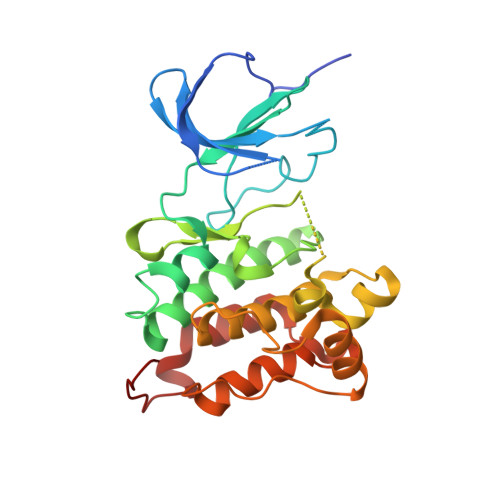De novo design of protein kinase inhibitors by in silico identification of hinge region-binding fragments.
Urich, R., Wishart, G., Kiczun, M., Richters, A., Tidten-Luksch, N., Rauh, D., Sherborne, B., Wyatt, P.G., Brenk, R.(2013) ACS Chem Biol 8: 1044-1052
- PubMed: 23534475
- DOI: https://doi.org/10.1021/cb300729y
- Primary Citation of Related Structures:
4FIC - PubMed Abstract:
Protein kinases constitute an attractive family of enzyme targets with high relevance to cell and disease biology. Small molecule inhibitors are powerful tools to dissect and elucidate the function of kinases in chemical biology research and to serve as potential starting points for drug discovery. However, the discovery and development of novel inhibitors remains challenging. Here, we describe a structure-based de novo design approach that generates novel, hinge-binding fragments that are synthetically feasible and can be elaborated to small molecule libraries. Starting from commercially available compounds, core fragments were extracted, filtered for pharmacophoric properties compatible with hinge-region binding, and docked into a panel of protein kinases. Fragments with a high consensus score were subsequently short-listed for synthesis. Application of this strategy led to a number of core fragments with no previously reported activity against kinases. Small libraries around the core fragments were synthesized, and representative compounds were tested against a large panel of protein kinases and subjected to co-crystallization experiments. Each of the tested compounds was active against at least one kinase, but not all kinases in the panel were inhibited. A number of compounds showed high ligand efficiencies for therapeutically relevant kinases; among them were MAPKAP-K3, SRPK1, SGK1, TAK1, and GCK for which only few inhibitors are reported in the literature.
Organizational Affiliation:
Drug Discovery Unit (DDU), Division of Biological Chemistry and Drug Discovery, College of Life Sciences, University of Dundee, Sir James Black Centre, DD1 5EH, UK.















